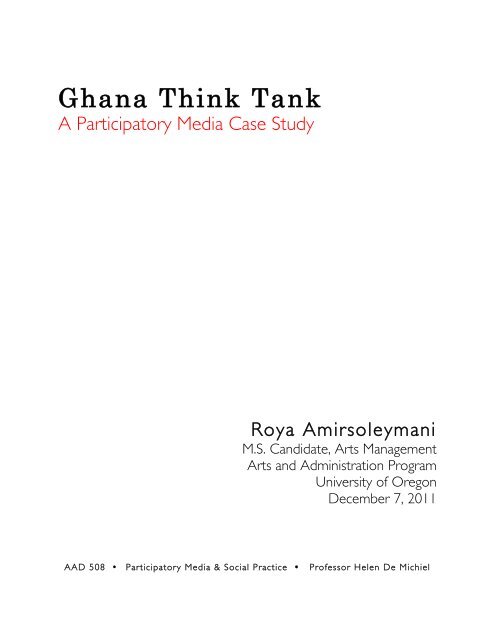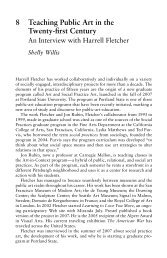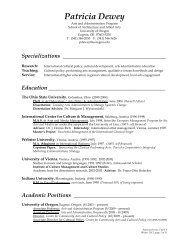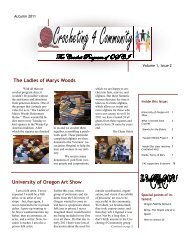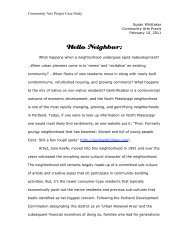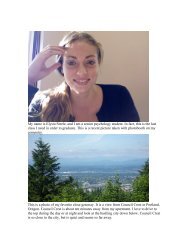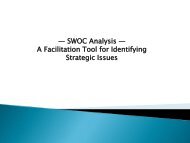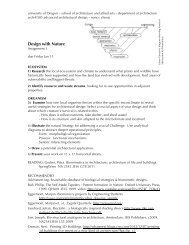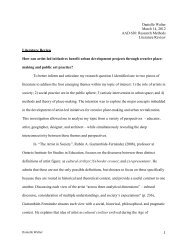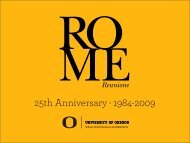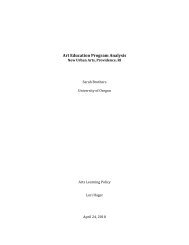Ghana Think Tank - School of Architecture and Allied Arts Blog ...
Ghana Think Tank - School of Architecture and Allied Arts Blog ...
Ghana Think Tank - School of Architecture and Allied Arts Blog ...
You also want an ePaper? Increase the reach of your titles
YUMPU automatically turns print PDFs into web optimized ePapers that Google loves.
<strong>Ghana</strong> <strong>Think</strong> <strong>Tank</strong><br />
A Participatory Media Case Study<br />
Roya Amirsoleymani<br />
M.S. C<strong>and</strong>idate, <strong>Arts</strong> Management<br />
<strong>Arts</strong> <strong>and</strong> Administration Program<br />
University <strong>of</strong> Oregon<br />
December 7, 2011<br />
AAD 508 Participatory Media & Social Practice Pr<strong>of</strong>essor Helen De Michiel
1. <strong>Ghana</strong> <strong>Think</strong> <strong>Tank</strong>: Dissolving Dichotomies<br />
On a number <strong>of</strong> levels, <strong>Ghana</strong> <strong>Think</strong> <strong>Tank</strong> strives to dissolve dichotomies, or disrupt those<br />
notions <strong>of</strong> difference that perpetuate cultural misunderst<strong>and</strong>ings <strong>and</strong> reinforce hegemonic<br />
power structures. By using self-organized citizen think tanks in “developing” nations to<br />
propose solutions to problems in “developed” ones, the project helps develop connections<br />
between cultural, social, political, <strong>and</strong> geographical groups that are <strong>of</strong>ten presented as<br />
inherently different or without points <strong>of</strong> convergence or intersection, presenting<br />
opportunities for intercultural connection <strong>and</strong> community interaction across false binary<br />
oppositions like East/West, first world/third world, religious/non-religious,<br />
democracy/theocracy, <strong>and</strong> old/young. In the context <strong>of</strong> participatory media, <strong>Ghana</strong> <strong>Think</strong><br />
<strong>Tank</strong> also breaks down a very particular assumed dichotomy: that <strong>of</strong> real/virtual worlds.<br />
A number <strong>of</strong> theories purport that the notion <strong>of</strong> any substantive difference between “real”<br />
<strong>and</strong> “virtual” worlds today is outdated, as the “tangible” elements <strong>of</strong> individual, communal,<br />
<strong>and</strong> social lived experiences <strong>of</strong>fline are inextricably intertwined with online <strong>and</strong> digital<br />
media, tools, <strong>and</strong> platforms. According to Lister, et. al (2009), “[i]n networked,<br />
technologically intensive societies we increasingly pass between actual <strong>and</strong> virtual realities”<br />
(2009, p. 37). In turn, these authors emphasize that simulations <strong>and</strong> simulated<br />
environments “are real, they exist, <strong>and</strong> are experienced within the real world which they<br />
augment” [emphasis is mine] (2009, p. 44).<br />
Charlie Gere (2008) argues for the value <strong>of</strong> our use <strong>of</strong> digital tools <strong>and</strong> culture to resist<br />
power <strong>and</strong> make social change, <strong>and</strong> <strong>Ghana</strong> <strong>Think</strong> <strong>Tank</strong> aims for social change <strong>and</strong> impact<br />
through innovative models for intercultural dialogue <strong>and</strong> community engagement.<br />
I would add that the value <strong>of</strong> digital tools Gere puts forth can be maximized through hybrid<br />
approaches to resistance activity, <strong>and</strong> <strong>Ghana</strong> <strong>Think</strong> <strong>Tank</strong> is an exemplary project in the<br />
realm <strong>of</strong> hybrid online/<strong>of</strong>fline programming <strong>and</strong> documentation that helps us move forward<br />
in theorizing notions <strong>and</strong> testing hypotheses <strong>of</strong> participatory media that ab<strong>and</strong>on the<br />
irrelevant real/virtual dichotomy. Lister, et. al. help frame the notion <strong>of</strong> combined<br />
<strong>of</strong>fline/online, or place-based/digital, or even (formerly) real/virtual participatory media<br />
designs <strong>and</strong> platforms <strong>and</strong> their value to digital resistance in new media.<br />
Thus, both the formerly “real” <strong>and</strong> formerly “virtual” are both real, <strong>and</strong> a hybridized<br />
approach to socially engaged art <strong>and</strong> resistance activity is critical if such projects aim to<br />
reach broad <strong>and</strong> diverse audiences, create conditions for active <strong>and</strong> rich public participation<br />
<strong>and</strong> dialogue, engender transformative experiences for participants, move communities<br />
toward positive social change initiatives <strong>and</strong> innovative problem-solving techniques, open<br />
up space for dialogue <strong>and</strong> intellectual <strong>and</strong> political exchange, <strong>and</strong> experiment with new<br />
approaches to living.<br />
As such, <strong>Ghana</strong> <strong>Think</strong> <strong>Tank</strong> is informed by Gere’s theory <strong>of</strong> the resistance capabilities <strong>of</strong><br />
digital culture <strong>and</strong> media well as that <strong>of</strong> Lister, et. al, who argue that the notion <strong>of</strong> a<br />
real/virtual binary is a false dichotomy; <strong>Ghana</strong> <strong>Think</strong> <strong>Tank</strong> collectively embodies <strong>and</strong><br />
practices these theories in such a way as to test the hypothesis that such resistance <strong>and</strong><br />
cultural activity—especially in the context <strong>of</strong> relational/participatory/socially engaged art<br />
<strong>and</strong> social practice—is most effective when both place-based <strong>and</strong> online components are<br />
incorporated, dissolving the distinction between real/virtual (or rather, helping to define a<br />
2
new norm that fully integrates both) that is in line with emerging research, theory, <strong>and</strong><br />
practice in both participatory art/media <strong>and</strong> arts participation.<br />
2. History <strong>and</strong> Overview <strong>of</strong> <strong>Ghana</strong> <strong>Think</strong> <strong>Tank</strong><br />
<strong>Ghana</strong> <strong>Think</strong> <strong>Tank</strong> (GTT) was created in 2006 by graduate students at the Rhode Isl<strong>and</strong><br />
<strong>School</strong> <strong>of</strong> Design as an art project now also considered to be an exercise in community <strong>and</strong><br />
cultural exchange. GTT is a “worldwide network <strong>of</strong> think tanks creating strategies to resolve<br />
local problems in the developed world” (2009, ffotogallery). This network includes selforganized<br />
think tanks in <strong>Ghana</strong>, Cuba, El Salvador, Serbia, Mexico, Ethiopia, Iran, <strong>and</strong> in a<br />
program for incarcerated girls in Boston, <strong>and</strong> are comprised <strong>of</strong> average citizens with no<br />
training or background in “international development” (C. Montoya, Personal<br />
communication, December 1, 2011).<br />
<strong>Ghana</strong> <strong>Think</strong> <strong>Tank</strong> exists as a computer- <strong>and</strong> internet-equipped teardrop trailer that visits<br />
first-world communities <strong>and</strong> asks locals to identify “problems” in their neighborhood, town,<br />
community, or city. Those problems are sent to the “third world” think tanks mentioned<br />
above, which collectively propose solutions to these first-world problems. According to the<br />
GTT website, “[s]ome <strong>of</strong> these actions have produced workable solutions, but others have<br />
created intensely awkward situations, as we play out different cultures' assumptions about<br />
each other.” (<strong>Ghana</strong> <strong>Think</strong> <strong>Tank</strong>, 2011)<br />
The final step <strong>of</strong> this exchange is for the “host” communities that initially posed the problem<br />
to enact one or more <strong>of</strong> the solutions proposed by the think tanks, thus experimenting with<br />
new methods for solving unusual problems. The results <strong>of</strong> many <strong>of</strong> these exchanges <strong>and</strong><br />
actions are documented, publicly presented, <strong>and</strong> formally exhibited in partnership with art<br />
spaces, museums, universities, nonpr<strong>of</strong>its, social service groups, <strong>and</strong> other commissioning<br />
or sponsoring institutions in the host communities, thus manifesting as both a social<br />
change-oriented <strong>and</strong> community-driven initiative <strong>and</strong> a contemporary art project, all the<br />
while serving multiple participant groups through positive, challenging, engaged<br />
interaction, including think tank members, host community members, audiences, exhibition<br />
viewers, <strong>and</strong> website visitors. Further detail on the step-by-process followed for each GTT<br />
project is provided below.<br />
3. Project Purpose: Intercultural Exchange through Experimental Problem Solving<br />
[<strong>Ghana</strong> <strong>Think</strong> <strong>Tank</strong>] has become a way to explore the friction caused by solutions that are<br />
generated in one context <strong>and</strong> applied elsewhere, while revealing the hidden assumptions<br />
that govern cross-cultural interactions.<br />
– <strong>Ghana</strong> <strong>Think</strong> <strong>Tank</strong> website, 2011<br />
<strong>Ghana</strong> <strong>Think</strong> <strong>Tank</strong> is a response to the problematic practice <strong>and</strong> power dynamics <strong>of</strong><br />
developed or first world nations “saving” or solving the problems <strong>of</strong> developing or third<br />
world nations through organized initiatives. According to an interview with GTT<br />
(Tikhonova, 2011), “[a]t the heart <strong>of</strong> this project is socially mediated problem solving, an<br />
activity which bridges divergent cultures <strong>and</strong> technologies. The intention is to transpose<br />
parts <strong>of</strong> one culture into another.”<br />
3
As discussed, in order to do this, the project partners with self-organized think tanks in the<br />
developing countries described above that generate “characteristically playful social<br />
interventions” in response to problems posed by communities in the developed/first world.<br />
According to <strong>Ghana</strong> <strong>Think</strong> <strong>Tank</strong>, “the ambition is to challenge the hidden assumptions that<br />
govern many cross-cultural interactions. Traditional power-roles are swapped, places are<br />
exchanged <strong>and</strong> communities are connected through what had previously been their<br />
differences.” (artspolicynow.org, 2011)<br />
The think tank process is three-fold, incorporating problems, solutions, <strong>and</strong> actions. It<br />
begins with GTT’s trailer being used in an actual community in the developed world (e.g.,<br />
German towns; New York City neighborhoods) to collect proposed problems. Host<br />
communities generally have some form <strong>of</strong> commissioning funding for GTT <strong>and</strong> work with<br />
project leaders to develop the procedural aspects <strong>of</strong> the partnership <strong>and</strong> the logistics <strong>of</strong><br />
bringing GTT to its physical site. The problems posed by host communities might include<br />
those that seem curious, humorous, or even inconsequential, such as a town being “too flat<br />
<strong>and</strong> boring” (Karlsruhe, Germany) or that “PowerPoint is ruining our minds”<br />
(MobilityShifts Conference, The New <strong>School</strong>, New York); more broadly social, such as old<br />
people being viewed as a burden to society (Wales) or the lack <strong>of</strong> sensory learning in the<br />
digital age (MobilityShifts Conference, The New <strong>School</strong>, New York); to highly specific <strong>and</strong><br />
divisive issues informed by ethnic, racial, <strong>and</strong> gender-based history, tension, violence, or<br />
social injustice, such as a lack <strong>of</strong> connection <strong>and</strong> communication between Serbs <strong>and</strong><br />
Albanians across the river in the town <strong>of</strong> Mitrovica (Serbia/Albania) or high levels <strong>of</strong> police<br />
harassment (Corona, Queens, New York City).<br />
Once problems are posed by locals in host communities, they are shared electronically with<br />
the self-organized think tanks explained above in any number <strong>of</strong> the developing countries<br />
who participate in GTT; the think tanks then generate <strong>and</strong> respond to the communities with<br />
proposed solutions taken from their own cultural <strong>and</strong> human contexts, thus contributing to<br />
a developing inter- <strong>and</strong> cross-cultural exchange between groups in two countries that<br />
probably know very little about one another, especially when it comes to the general public<br />
who comprise participants on both ends.<br />
One <strong>of</strong> GTT’s core artists/group leaders, Carmen Montoya, describes the organization <strong>of</strong><br />
think tanks <strong>and</strong> how they fit into the overall project scheme:<br />
The think tanks grow out <strong>of</strong> personal connections with people in other countries or who work in<br />
domestic organizations…sometimes a think tank is a pre-existing group, as with Artistic Noise,<br />
who make up the Incarcerated Girls think tank in Boston. In El Salvador, the think tank is<br />
composed <strong>of</strong> people who run a community radio station. We are currently developing think tanks<br />
in the migrant worker community in Oregon through PCUN <strong>and</strong> in the Oregon prison system. We<br />
keep in contact with the think tanks via email, sending problems, receiving solutions <strong>and</strong> providing<br />
documentation <strong>and</strong> feedback about the implementation <strong>of</strong> solutions. (Personal Communication,<br />
December 1, 2011)<br />
The third step, action, involves the initial host community implementing or enacting one or<br />
more <strong>of</strong> the think tanks’ proposed solutions, whether they seem to make sense or not. This<br />
is an exercise in experimentation that privileges the process <strong>of</strong> community engagement,<br />
dialogue, <strong>and</strong> exchange over end results. However, the larger public in a given host<br />
community has a chance to participate in actions either directly or through exhibitions in<br />
4
museums, art spaces, or other public settings that display the results <strong>of</strong> this three-step<br />
problem-solution-action process <strong>and</strong> its documentation.<br />
One example <strong>of</strong> this process is in Wales, where GTT settled on addressing the problem that<br />
“there seems to be a perception that old people are a burden to society”. The GTT think tank<br />
in Iran then proposed the solution that that communities collect “dirty” stories from their<br />
local old folks (that is, ask them about their sex lives). Communities in Wales took action on<br />
this by partnering with senior citizen centers to produce oral history projects that included<br />
recorded interviews with residents/visitors about their memories <strong>of</strong> first kisses, sex, love,<br />
<strong>and</strong> romance—which proved quite entertaining for the community! The final project was<br />
exhibited as a project <strong>of</strong> <strong>Ghana</strong> <strong>Think</strong> <strong>Tank</strong> at the National Museum <strong>of</strong> Wales.<br />
<strong>Ghana</strong> <strong>Think</strong> <strong>Tank</strong> has a ten-year project plan. Group leaders will assess GTT in 2016 to<br />
determine how to proceed <strong>and</strong> take stock <strong>of</strong> shape, form, <strong>and</strong> direction at that point. After<br />
those ten years, as co-founder Chris Robbins stated in an interview, “we'll see if it has grown<br />
into something else entirely...” (Personal communication, December 1, 2011).<br />
3. Project Leaders<br />
Rhode Isl<strong>and</strong> <strong>School</strong> <strong>of</strong> Design (RISD) graduate students <strong>and</strong> friends Chris Robbins, John<br />
Ewing, <strong>and</strong> Matey Odonkor founded <strong>Ghana</strong> <strong>Think</strong> <strong>Tank</strong> in 2006 as a ten-year project. After<br />
Odonkor left the group, visual artist Maria del Carmen Montoya, who also attended RISD,<br />
joined as the other project leader. Thus, artists became involved in the project through their<br />
shared education, intellectual exchange, <strong>and</strong> artistic collaboration <strong>and</strong> agreed to collectively<br />
develop, fund, maintain, <strong>and</strong> program the project.<br />
Maria del Carmen Montoya is a new media artist who works in sculpture, performance,<br />
<strong>and</strong> video. Her work explores the personal, emotional, <strong>and</strong> utterly irrational tendencies <strong>of</strong><br />
technology. Her collaborative projects include WineBloodBloodLove, a performance <strong>and</strong><br />
sound installation inside the Herman Nitsch retrospective at the Station Museum in<br />
Houston, <strong>and</strong> the creation <strong>of</strong> The Digital Poplar Consort, a family <strong>of</strong> h<strong>and</strong>crafted wireless<br />
musical instruments used in a concert. Her most recent work I Sky You, winner <strong>of</strong> a 2009<br />
Rhizome commission, is an installation that sonifies the radiance <strong>of</strong> chemically synthesized<br />
light. (www.eyebeam.org, retrieved 12/5/11)<br />
Christopher Robbins works on the uneasy cusp <strong>of</strong> public art <strong>and</strong> community action,<br />
creating sculptural interventions in the daily lives <strong>of</strong> strangers. He uses heavy material<br />
dem<strong>and</strong>s <strong>and</strong> a carefully twisted work-process to craft awkwardly intimate social<br />
collaborations.<br />
He built his own hut out <strong>of</strong> mud <strong>and</strong> sticks <strong>and</strong> lived in it while serving as a Peace Corps<br />
Volunteer in Benin, West Africa, spoke at a United Nations conference about his crosscultural<br />
digital arts <strong>and</strong> education work in the South Pacific, <strong>and</strong> has lived <strong>and</strong> worked in<br />
London, Tokyo, West Africa, the Fiji Isl<strong>and</strong>s, <strong>and</strong> former Yugoslavia. He has exhibited at the<br />
New Museum Festival <strong>of</strong> Ideas, Trade <strong>School</strong> at the Whitney Museum, the National<br />
Museum <strong>of</strong> Wales, PERFORMA 07, Nikolaj Kunsthallen/ Copenhagen Contemporary Art<br />
Center, <strong>and</strong> been awarded residencies/ fellowships from Skowhegan, MacDowell Colony,<br />
Haystack, Penl<strong>and</strong>, <strong>and</strong> Anderson Ranch, among others.<br />
5
The <strong>Ghana</strong> <strong>Think</strong> <strong>Tank</strong>, a project he co-founded in 2006, was a finalist for the Frieze<br />
Foundation Cartier Award in 2010 <strong>and</strong> was awarded the Creative Time Open Doors<br />
commission for Public Art at the Queens Museum <strong>of</strong> Art in 2010. (www.christopherrobbins.com;<br />
retrieved 12/5/11)<br />
John Ewing is a digital media artist creating public art with an emphasis on community<br />
participation. He works on large sustained projects that <strong>of</strong>ten last several years. He has<br />
exhibited at the National Museum <strong>of</strong> Wales, FACT, the Foundation for Art <strong>and</strong> Creative<br />
Technology, <strong>and</strong> the Cambridge <strong>Arts</strong> Council, with upcoming shows in New York City <strong>and</strong><br />
Shanghai, China. Previously he worked in El Salvador for two years, using the arts to<br />
organize <strong>and</strong> inspire dialogue about human rights. Other work includes projects in<br />
Nicaragua, Uruguay <strong>and</strong> Cuba, as well as various cities in the U.S. In 2009 he was a<br />
recipient <strong>of</strong> the Knight News Challenge Grant. The <strong>Ghana</strong> <strong>Think</strong> <strong>Tank</strong> has been shortlisted<br />
for the 2010 Cartier Award. (dm.risd.edu; retrieved 12/5/11)<br />
4. Project Partners<br />
Aside from the project leaders mentioned above, the following individuals/groups are<br />
involved with <strong>Ghana</strong> <strong>Think</strong> <strong>Tank</strong> as partner organizations, individual volunteers, or<br />
contracted consultants:<br />
• The Vera List Center for Art at The New <strong>School</strong> (New York City) is dedicated<br />
to serving as a catalyst for the discourse on the role <strong>of</strong> the arts in society <strong>and</strong> their<br />
relationship to the sociopolitical climate in which they are created.<br />
• Kevin Patton, Asst. Pr<strong>of</strong>essor <strong>of</strong> Music <strong>and</strong> Performance Technologies at Oregon<br />
State University, manages GTT’s physical computing<br />
• AJ McGuire is GTT’s webs designer<br />
• Rachel Pedderson, Catherine McTague, <strong>and</strong> Tom Kietz were GTT’s most<br />
recent associates.<br />
• Host communities in the developed world, which put forth the “problems” to be<br />
solved by self-organized, citizen think tanks in developing countries, including<br />
<strong>Ghana</strong>, Cuba, El Salvador, Cambodia, Mexico, the Gaza Strip, Lebanon, Afghanistan,<br />
Iran, Kosovo, Serbia, <strong>and</strong> within Artistic Noise, a program for incarcerated girls in<br />
Boston, Massachusetts.<br />
According to Carmen Montoya (Personal interview, December 1, 2011), “many <strong>of</strong> [GTT’s]<br />
partners grow out <strong>of</strong> relationships in the host community <strong>and</strong> change depending on the<br />
context…for example, in Corona, Queens we worked with the Lion´s Club, Tania Bruguera´s<br />
Immigrant Movement International, <strong>and</strong> Make the Road NY. In Karlsruhe, Germany we<br />
worked with Noah´s Arc Senior Center, Movement Karlsruhe, a parkour [French martial<br />
arts] club, <strong>and</strong> improvisational theatre SERVIERVORSCHLAG.” Thus, Montoya shares here<br />
GTT’s model for temporary partnerships that are site-specific, culturally appropriate, <strong>and</strong><br />
arise as obvious choices for collaboration based on the “problems” posed by community<br />
members as well as their choice <strong>of</strong> “action” or implementation <strong>of</strong> think tanks’ solutions.<br />
Upcoming project partners include the US State Department’s smART Power program, the<br />
Bronx Museum <strong>of</strong> Art, <strong>and</strong> the Arab Image Foundation (<strong>Ghana</strong> <strong>Think</strong> <strong>Tank</strong> website,<br />
retrieved 12/4/11).<br />
6
5. Funding <strong>and</strong> Resources<br />
The following organizations have or continue to support <strong>Ghana</strong> <strong>Think</strong> <strong>Tank</strong> through grants,<br />
donations, <strong>and</strong> commissions. In turn, the group leaders <strong>of</strong>ten front the costs <strong>of</strong> various<br />
incarnations <strong>of</strong> the project until funding is secured through other means. Because GTT is<br />
not a 501(c)(3), it receives fiscal sponsorship through various entities when applying for<br />
grants, or group leaders apply for or seek funding individually or collectively as artists.<br />
Project leader Christopher Robbins has mentioned the group’s interest in the possibility <strong>of</strong><br />
pursuing for-pr<strong>of</strong>it, LLC status (Personal communication, December 1, 2011)<br />
• CEC <strong>Arts</strong>Link promotes international communication <strong>and</strong> underst<strong>and</strong>ing through<br />
collaborative, innovative arts projects for mutual benefit.<br />
• SUNY Purchase College brings two styles <strong>of</strong> education—traditional liberal arts<br />
<strong>and</strong> sciences programs <strong>and</strong> conservatory-based arts programs—into close contact on<br />
one campus, thus striving to inspire an appreciation for both intellectual <strong>and</strong> artistic<br />
talents in all students.<br />
• The Rockefeller Foundation supports work that enables individuals,<br />
communities, <strong>and</strong> institutions to access new tools, practices, resources, services, <strong>and</strong><br />
products.<br />
• Queens Museum <strong>of</strong> Art in New York City presents artistic <strong>and</strong> educational<br />
programs <strong>and</strong> exhibitions that directly relate to the contemporary urban life <strong>of</strong> its<br />
constituents while maintaining the highest st<strong>and</strong>ards <strong>of</strong> pr<strong>of</strong>essional, intellectual,<br />
<strong>and</strong> ethical responsibility.<br />
• Creative Time: Guided by a passionate belief in the power <strong>of</strong> art to create inspiring<br />
personal experiences as well as foster social progress, Creative Time strives to<br />
commission, produce <strong>and</strong> present the most important, ground-breaking, challenging<br />
<strong>and</strong> exceptional art <strong>of</strong> our times—art that infiltrates the public realm <strong>and</strong> engages<br />
millions <strong>of</strong> people in New York City <strong>and</strong> across the globe.<br />
• The Lily Auchincloss Foundation supports art, preservation <strong>and</strong> community<br />
programs that serve to enrich the lives <strong>of</strong> the City.<br />
• Puffin Foundation, Ltd. seeks to open the doors <strong>of</strong> artistic expression by<br />
providing grants to artists <strong>and</strong> art organizations that are <strong>of</strong>ten excluded from<br />
mainstream opportunities due to their race, gender, or social philosophy.<br />
• The Black Rock <strong>Arts</strong> Foundation supports <strong>and</strong> promotes community,<br />
interactive art <strong>and</strong> civic participation.<br />
• The Greenwall Foundation formerly operated an arts <strong>and</strong> humanities program<br />
focused on support for small <strong>and</strong> midsize New York City arts organizations,<br />
especially those fostering experimentation <strong>and</strong> creation <strong>of</strong> new <strong>and</strong> interdisciplinary<br />
work in theater, dance, music, visual <strong>and</strong> literary arts, <strong>and</strong> new media.<br />
• New York City Department <strong>of</strong> Cultural Affairs (DCLA) is dedicated to<br />
supporting <strong>and</strong> strengthening New York City's vibrant cultural life. Among our<br />
primary missions is to ensure adequate public funding for non-pr<strong>of</strong>it cultural<br />
organizations, both large <strong>and</strong> small, throughout the five boroughs.<br />
• New York State Council on the <strong>Arts</strong> is dedicated to preserving <strong>and</strong> exp<strong>and</strong>ing<br />
the rich <strong>and</strong> diverse cultural resources that are <strong>and</strong> will become the heritage <strong>of</strong> New<br />
York's citizens <strong>and</strong> believes in supporting artistic excellence <strong>and</strong> creative freedom <strong>of</strong><br />
artists without censure, the rights <strong>of</strong> all New Yorkers to access <strong>and</strong> experience the<br />
7
power <strong>of</strong> art <strong>and</strong> culture, <strong>and</strong> the vital contribution the arts make to the quality <strong>of</strong> life<br />
in New York communities.<br />
6. Participation Model: Engagement in Both Digital <strong>and</strong> Place-Based Contexts<br />
<strong>Ghana</strong> <strong>Think</strong> <strong>Tank</strong> clearly, comprehensively, <strong>and</strong> purposefully embodies the participatory<br />
qualities <strong>of</strong> community (Week 9). As put forth in our course syllabus, GTT is a transmedia<br />
project “continually grounded in real history, real geography, <strong>and</strong> real time—what we know<br />
as human beings” (Participatory Media <strong>and</strong> Social Practice course blog; retrieved 12/5/11).<br />
This is in part evidenced by GTT’s model <strong>of</strong> engaging real people from divergent cultures<br />
<strong>and</strong> specific communities through self-organized citizen think tanks in developing countries<br />
paired with the project’s connection to actual locals in host communities in developed<br />
countries who put forth the “problems” addressed by the think tanks. By using a physical<br />
trailer that travels throughout the host community seeking input <strong>and</strong> responses on<br />
community problems from locals in public spaces—while providing the privacy <strong>of</strong> the trailer<br />
<strong>and</strong> a personal computer to submit the “problems” in question—GTT welcomes input on<br />
civic, artistic, or even completely irreverent problems, questions, or concerns from<br />
concerned, engaged citizens or those who simply feel welcome to participate in a creative<br />
project thanks to GTT’s open forum <strong>and</strong> method <strong>of</strong> soliciting participation. The trailer could<br />
be parked at a commissioning art space, organization or institution, in a public square, or<br />
outside a government building—somewhere accessible <strong>and</strong> visible to the public. GTT project<br />
<strong>and</strong> partner leaders or volunteers are on h<strong>and</strong> to assist participants if they have questions or<br />
need help submitting a problem via the computer stations or other means.<br />
GTT think tanks demonstrate very particular models for community engagement informed<br />
by culturally specific ways <strong>of</strong> organizing a group <strong>of</strong> people in a developing country to<br />
participate in moving a project through its process. While GTT projects have some<br />
connection to the think tank being formed in a given location, they do not necessarily know<br />
who will end up being in the group, only that the members will not have any experience in<br />
“international development”, which plays into GTT’s subversion <strong>of</strong> the traditional top-down<br />
model <strong>of</strong> global problem-solving.<br />
Thus, these communities form somewhat organically—through a combination <strong>of</strong> in-person<br />
<strong>and</strong> electronic communication forums, or because they are all involved in another<br />
community project together (e.g., a radio station)—<strong>and</strong> manage their time, meetings, <strong>and</strong><br />
ongoing contributions to GTT from their home site, on a volunteer basis, forming a<br />
community that connects with the project leaders as well as the host community to which<br />
they are posing solutions to problems, creating a larger, more complex network <strong>of</strong><br />
intercultural exchange <strong>and</strong> dialogue that transcends the traditional notion <strong>of</strong> real versus<br />
virtual divisions <strong>of</strong> space, place, <strong>and</strong> time. The exception to this organic model <strong>of</strong> think tank<br />
formation/organization is the Artistic Noise program for incarcerated girls in Boston, which<br />
builds the think tank into its programming more formally.<br />
Critical to <strong>Ghana</strong> <strong>Think</strong> <strong>Tank</strong>’s online presence <strong>and</strong> use <strong>of</strong> digital tools <strong>and</strong> media are<br />
documentation <strong>and</strong> archival practices for tracking each cultural exchange arising out <strong>of</strong><br />
GTT. Initial community problems are <strong>of</strong>ten posed electronically through computers in the<br />
GTT trailer. <strong>Think</strong> tanks in developing countries document their decision-making processes<br />
8
through photo <strong>and</strong> video. Both GTT <strong>and</strong> its’ presenting partner organizations document <strong>and</strong><br />
archive projects on their websites through photos, videos, news feeds, <strong>and</strong> blogs <strong>and</strong><br />
through social media outlets, particularly Facebook <strong>and</strong> Twitter.<br />
7. Community-specific Impact: Transformative Participatory Experiences<br />
GTT co-leader Carmen Montoya tells a touching story about the impact <strong>of</strong> <strong>Ghana</strong> <strong>Think</strong><br />
<strong>Tank</strong> that exemplifies the interpersonal connection <strong>and</strong> community collaboration brought<br />
about by successful GTT projects. Here she discusses an incarnation in Germany <strong>of</strong> a<br />
problem originally put forth by someone n Wales: “the elderly are treated like a burden to<br />
society,” to which Iran’s think tank responded, “collect funny dirty stories from old people.”<br />
GTT was in Karlsruhe, Germany for the Global Contemporary Show. I arranged a tea at Noah´s Arc<br />
Senior Center in hopes that I might find someone willing to talk to me there. When I arrived the<br />
administrators ushered me into the back room <strong>of</strong>fice for a briefing. I was told that the center had hosted<br />
artistic projects in the past <strong>and</strong> that they were always very hard for the seniors. I was solemnly reminded<br />
that everyone at the tea that afternoon had lived through World War II, through terrible tragedies, had<br />
suffered hunger, sudden loss <strong>of</strong> family <strong>and</strong> friends, <strong>and</strong> other unspeakable events. Remembering the past<br />
was <strong>of</strong>ten an unpleasant exercise. I explained that I only wanted to socialize with them in a natural way<br />
<strong>and</strong> that there would be none <strong>of</strong> the typical prodding. My plan was to have tea <strong>and</strong> to have fun.<br />
There was a woman there named Carmen who spoke fluent Spanish. She explained that she learned<br />
Spanish from her husb<strong>and</strong>, with whom she had to flee to Holl<strong>and</strong> to marry. In the 1950s it was illegal to<br />
marry a divorcé (her husb<strong>and</strong> was divorced) in Germany, so they ran away together, leaving everything<br />
<strong>and</strong> everyone to marry in Holl<strong>and</strong>. As we drank tea <strong>and</strong> ate cake, a far-away look came over her face <strong>and</strong><br />
she said, "Oh, those were good days." She told me about romps in the bushes on the way out <strong>of</strong> town <strong>and</strong><br />
was simply giddy after our chat. People around us became curious about the unintelligible Spanish <strong>and</strong> all<br />
the giggles, <strong>and</strong> soon people were volunteering <strong>and</strong> jesting about who was naughtier than the other. By<br />
the end <strong>of</strong> tea, we were all one enormous group <strong>of</strong> giggling senior citizens (plus me) vying for the title <strong>of</strong><br />
"most naughty," grabbing at the recorder for a chance to go back to those "lovely days"... to kiss <strong>and</strong> tell. It<br />
was such fun. The uniqueness <strong>of</strong> GTT is that the project is about the community´s agenda. As artists, we<br />
are but catalysts for a dialogue just waiting to happen. (Personal communication, December 1, 2011).<br />
As Montoya says, one <strong>of</strong> the most unique qualities <strong>of</strong> <strong>Ghana</strong> <strong>Think</strong> <strong>Tank</strong> is its ability to<br />
create conditions for community to come together around what it is they need or want, not<br />
to impose solutions or notions <strong>of</strong> what works best elsewhere. The community’s “agenda”<br />
guides the project through both its process <strong>and</strong> its end results, which really don’t end, but<br />
rather reverberate throughout the communities it touches through conversation <strong>and</strong><br />
dialogue, memory, <strong>and</strong> tangible change.<br />
8. Methods <strong>of</strong> Participation<br />
<strong>Ghana</strong> <strong>Think</strong> <strong>Tank</strong>’s process, methods, vision, <strong>and</strong> values demonstrate an awareness <strong>of</strong> <strong>and</strong><br />
emphasis on emerging arts participation theory <strong>and</strong> practice. For example, as previously<br />
described, GTT is committed to presenting projects in both place-based <strong>and</strong> digital contexts,<br />
which allows it to serve the mission <strong>of</strong> many <strong>of</strong> its funders <strong>and</strong> sponsors in making socially<br />
engaged, community-oriented experimental art available <strong>and</strong> accessible to a broad public.<br />
GTT’s combined use <strong>of</strong> electronic, digital, <strong>and</strong> place-based engagement methods<br />
demonstrates their value <strong>of</strong> a variety <strong>of</strong> methods <strong>of</strong> interactivity <strong>and</strong> presentation that serve<br />
a number <strong>of</strong> purposes: participants with lower levels <strong>of</strong> media literacy can still participate in<br />
9
the project; those who seek more online interaction <strong>and</strong> exchange have a plethora <strong>of</strong><br />
resources, information, <strong>and</strong> archival images <strong>and</strong> texts to reference after the projects are<br />
complete; funders can easily track the trajectory <strong>of</strong> a project; multiple partners can share<br />
the project on their own websites; <strong>and</strong> exhibitions <strong>of</strong> projects’ final products can employ<br />
both place-based <strong>and</strong> digital tools for engaging current <strong>and</strong> new audiences, or those who<br />
were already a part <strong>of</strong> the project as well as those br<strong>and</strong> new to it. This demonstrates an<br />
awareness on the part <strong>of</strong> GTT <strong>of</strong> the need for multiple nodes <strong>of</strong> entry for participants <strong>and</strong><br />
the provision <strong>of</strong> multiple levels <strong>and</strong> types <strong>of</strong> interaction <strong>and</strong> engagement options for<br />
audiences, viewers, visitors, <strong>and</strong> participants, which can be tailored in terms <strong>of</strong> cultural<br />
context, site specificity, media literacy, <strong>and</strong> community dynamics. The need for making<br />
diverse levels <strong>and</strong> methods <strong>of</strong> participation available to audiences <strong>and</strong> publics is an<br />
emerging best practice in arts <strong>and</strong> culture programming, supported by recent research from<br />
museum studies scholar Nina Simon in her book The Participatory Museum (2010) <strong>and</strong><br />
The James Irvine Foundation’s report Getting In On the Act: How <strong>Arts</strong> Groups are<br />
Creating Opportunities for Active Participation (2011).<br />
9. Weathering Economic <strong>and</strong> Technical Challenges<br />
Neither Robbins nor Montoya feel that <strong>Ghana</strong> <strong>Think</strong> <strong>Tank</strong> is currently faced with<br />
exceptional economic challenges, though they maintain that the project’s operations are<br />
sustainable <strong>and</strong> lean, using as much recycled material <strong>and</strong> found resources as possible, <strong>and</strong><br />
that they <strong>of</strong>ten rely on the generosity <strong>of</strong> volunteers. Says Montoya, “this is possible in part<br />
because the issues we work with are ones that rise up from the community <strong>and</strong> people have<br />
an interest in resolving.” In turn, GTT’s core artists (Robbins, Montoya, <strong>and</strong> Ewing) have<br />
other means <strong>of</strong> supporting themselves <strong>and</strong> so will <strong>of</strong>ten front the cost <strong>of</strong> an initial project<br />
while awaiting institutional support, or they will work for very small honorarium fees.<br />
“Funding has not been ideal, but we make it work,” says Montoya (Personal communication,<br />
December 1, 2011).<br />
However, Montoya <strong>and</strong> Robbins both agree that there are broader financial challenges to be<br />
addressed than simply the amount <strong>of</strong> funds that can be garnered to sustain the project in its<br />
current form. For one, because GTT was started as an independent art project by friends, it<br />
lacks a strong operational, managerial, <strong>and</strong> procedural infrastructure, including by-laws, a<br />
board, <strong>and</strong> clear guidelines for decision-making. Robbins identified the need for a<br />
consultant to address some <strong>of</strong> these organizational gaps <strong>and</strong> prevent future<br />
miscommunications or problems, especially as the project scales up. Robbins also discussed<br />
the challenge <strong>of</strong> responding to increased partnership <strong>and</strong> exhibition opportunities. “As we<br />
continue to work on the project, our sense <strong>of</strong> scope <strong>and</strong> responsibility exp<strong>and</strong>s,” says<br />
Robbins. “We want to bring think tanks to the US <strong>and</strong> visit them ourselves. We want to<br />
extend the scale <strong>of</strong> projects beyond the relatively short (3-6 month) timescale <strong>of</strong> art shows.<br />
This requires longer-term partnerships that outlive specific art shows, <strong>and</strong> more funding<br />
<strong>and</strong> management than a typical exhibit.” (Personal communication, December 1, 2011)<br />
In response to such challenge <strong>and</strong> opportunity, the group has begun to reach out to non-art<br />
donors—such as those who make grants for community engagement <strong>and</strong> inter-ethnic<br />
reconciliation projects—as well as to much larger arts-related funders, including Creative<br />
Capital, the Rockefeller Foundation, <strong>and</strong> ArtSpace. In turn, the group has considered<br />
forming an LLC, especially in light <strong>of</strong> the fact that their work can be highly subversive <strong>and</strong>,<br />
in some cases, even illegal. Another funding option, which has become more prevalent in<br />
10
the nonpr<strong>of</strong>it arts sector recently, is fiscal sponsorship under an existing nonpr<strong>of</strong>it, which<br />
could potentially provide both funding <strong>and</strong> legal protection. The group has also considered<br />
forming as their own 501(c)(3) nonpr<strong>of</strong>it (Robbins, Personal Interview, 12/1/11).<br />
Montoya discussed other challenges faced by the group. “We suffer from physical<br />
distance…[t]he three <strong>of</strong> us [Montoya, Robbins, <strong>and</strong> Ewing] are scattered in different cities<br />
<strong>and</strong> we feel we would benefit from extended time together, sharing quarters <strong>and</strong> having<br />
continuous contact during the execution <strong>of</strong> a project…life gets complicated <strong>and</strong> the logistics<br />
<strong>of</strong> the project suffer due to the dem<strong>and</strong>s <strong>of</strong> daily life.” Montoya is quick to add, however,<br />
that a “triangle”, or three-person team, is also “the most stable structure.” Montoya also<br />
mentioned that some <strong>of</strong> technological challenges—or at least a need for oversight <strong>and</strong><br />
advancement in this area—have recently been addressed by adding Kevin Patton to the team<br />
as physical computing consultant. Patton creates custom technology for each exhibition (C.<br />
Montoya, personal communication, December 1, 2011).<br />
10. Transcendent Communities: Crossing Borders, Blurring Boundaries<br />
Some aspects <strong>of</strong> how <strong>Ghana</strong> <strong>Think</strong> <strong>Tank</strong> generates cross-cultural connection,<br />
communication, <strong>and</strong> community have already been discussed (see Section 6). To elaborate,<br />
it is important to draw attention to the project’s aims <strong>and</strong> successes in developing projects<br />
that put groups <strong>of</strong> average citizens in dialogue with one another using GTT’s unique,<br />
exploratory problem-solving method as an “ice breaker” <strong>of</strong> sorts in generating a connection.<br />
Both the think tanks in developing countries (or other underserved areas, such as US<br />
prisons) as well as host communities in developed areas have a stake in the process—<strong>and</strong> in<br />
some ways, the outcomes—<strong>of</strong> the action steps taken to implement the think tanks’ proposed<br />
solutions in response to the problems put forth by host communities.<br />
This creates a literal exchange—<strong>of</strong>ten across a vast physical distance—between, as <strong>Ghana</strong><br />
<strong>Think</strong> <strong>Tank</strong> terms it, “divergent” cultures. If members <strong>of</strong> either a GTT think tank or host<br />
community did not participate in GTT, they would likely never have the opportunity to be<br />
exposed to <strong>and</strong> openly discuss the cultural ideas <strong>and</strong> values <strong>of</strong> the other group <strong>and</strong> its<br />
individual members, nor to learn so intimately about a specific place, or<br />
geographical/cultural/social context, <strong>and</strong> the impressions, memories, associations,<br />
frustrations, <strong>and</strong> delights its own local community members have <strong>of</strong> it. For example, other<br />
than through the vision <strong>and</strong> mission <strong>of</strong> a project like <strong>Ghana</strong> <strong>Think</strong> <strong>Tank</strong>, how likely would it<br />
be for a group <strong>of</strong> poor Filipina immigrant women in Lebanon to become intimately<br />
acquainted with the local residents <strong>of</strong> Corona, Queens, New York <strong>and</strong> their perceptions <strong>of</strong><br />
the place they call home? <strong>Ghana</strong> <strong>Think</strong> <strong>Tank</strong>’s mission <strong>and</strong> model break down barriers to<br />
intimate yet broadly human intercultural communication <strong>of</strong> this sort, allowing diverse<br />
cultural communities to connect.<br />
11. Cross-Sector Interaction <strong>and</strong> Outreach<br />
While also previously discussed, it is important to address these aspects <strong>of</strong> <strong>Ghana</strong> <strong>Think</strong><br />
<strong>Tank</strong>’s organization in this context <strong>of</strong> cross-sector connection <strong>and</strong> collaboration. According<br />
to both Montoya <strong>and</strong> Robbins, they identify how GTT has already begun to actively diversify<br />
its funding sources across sectors, including turning to international NGOs, peace-building<br />
initiatives, <strong>and</strong> grassroots community development organizations for grant funding <strong>and</strong><br />
11
support. In turn, the individual projects conducted by or commissioned for <strong>Ghana</strong> <strong>Think</strong><br />
<strong>Tank</strong> almost always work across sectors. A single project might involve place-based<br />
interaction (collecting “problems” from neighborhood locals using the GTT trailer) in front<br />
<strong>of</strong> the Queens Museum <strong>of</strong> Art or at the city- <strong>and</strong> cultural planning-oriented Festival <strong>of</strong> New<br />
Ideas in New York City; a think tank in El Salvador comprised <strong>of</strong> community radio station<br />
members; an exhibition <strong>of</strong> the project’s process, outcomes, <strong>and</strong> documentation at a local<br />
nonpr<strong>of</strong>it art space for both existing <strong>and</strong> current audiences; <strong>and</strong> online image <strong>and</strong><br />
discussion content on the GTT website or social media platforms that engages participations<br />
from across sectors <strong>and</strong> around the world.<br />
An example <strong>of</strong> GTT’s success in this regard would actually be the hypothetical example<br />
described above, since it is really a combination <strong>of</strong> actual events <strong>and</strong> actions associated with<br />
real GTT projects. Another example would be a recent commission from the US State<br />
Department’s smART Power program, a new initiative that seeks to use art for international<br />
development purposes. GTT sees its role in this commission as one that would be helping a<br />
primary institution <strong>of</strong> international political power re-assess, problematize, <strong>and</strong> re-work<br />
st<strong>and</strong>ard approaches to international development. This commission truly exemplifies a<br />
cross-sector collaboration, in this case between international government <strong>and</strong> independent,<br />
experimental art (<strong>and</strong> between groups that demonstrate approaches to international <strong>and</strong><br />
humanitarian politics that differ highly, if not being fundamentally opposed)<br />
A future cross-sector partnership goal for <strong>Ghana</strong> <strong>Think</strong> <strong>Tank</strong> is its desire to branch out even<br />
further in establishing funding <strong>and</strong> collaboration relationships with non-arts groups while<br />
also exp<strong>and</strong>ing its audience <strong>and</strong> participation demographic—as well as the public’s<br />
perception <strong>of</strong> the program’s value—through this diversified funding/outreach model that<br />
exposes new audiences to GTT.<br />
12. Putting Communities First: Contextualizing Digital <strong>and</strong> Participatory Media<br />
Part <strong>of</strong> what makes <strong>Ghana</strong> <strong>Think</strong> <strong>Tank</strong> unique is that it strikes a good balance between using<br />
digital tools, media, <strong>and</strong> online platforms to augment its place-based programming while<br />
also incorporating some digital-specific elements. For example, without electronic<br />
communication devices, the “third world” think tanks involved in the project would never be<br />
organized or enabled to share solutions to first-world communities’ problems. In turn,<br />
computers with electronic processes for submitting community “problems” are set up inside<br />
actual trailers that visit physical locations <strong>and</strong> public spaces, thus concretely merging online<br />
<strong>and</strong> <strong>of</strong>fline interaction, connection, <strong>and</strong> engagement. The project does a very good job <strong>of</strong><br />
employing sophisticated digital tools <strong>and</strong> media <strong>and</strong> demonstrably recognizing their value<br />
while not privileging or glorifying them, thus exercising an awareness <strong>of</strong> the false complex<br />
politics <strong>and</strong> workings <strong>of</strong> technology on a social level in such a way that feels different from<br />
other projects we explored this term.<br />
For one, <strong>Ghana</strong> <strong>Think</strong> <strong>Tank</strong> is not overtly political in its praise or critique <strong>of</strong> digital media<br />
or, alternatively, community connection. It truly seeks to empower communities to define<br />
for themselves how they want to approach addressing, resolving, <strong>and</strong> discussing local issues.<br />
If a given project were more “digital” in focus—such as the concentration on “digital<br />
problems” with the group at the New <strong>School</strong>’s MobilityShifts conference in New York—than<br />
the level <strong>of</strong> digital presence <strong>and</strong> media that particular project might have on the GTT<br />
website would reflect this focus.<br />
12
This awareness <strong>of</strong> the productive tension <strong>and</strong> relationship between digital/analog allows<br />
<strong>Ghana</strong> <strong>Think</strong> <strong>Tank</strong> to uniquely tackle community problems from a variety <strong>of</strong> angles, without<br />
prescribing a particular project or program design <strong>and</strong> taking it into communities. Rather,<br />
with very loose processes in place—<strong>and</strong> the provision <strong>of</strong> tools more than rules—the project<br />
opens up opportunities for community engagement <strong>and</strong> leaves doors for content, process,<br />
<strong>and</strong> results wide open, demonstrating its commitment to process <strong>and</strong> experimentation (<strong>and</strong><br />
in some ways, resistance to quantifiable data) above all else, which in turn lies in its roots as<br />
an experimentation in socially mediated art, not a nonpr<strong>of</strong>it organization, or a research<br />
initiative, or a public <strong>of</strong>fice.<br />
While there is room for GTT to grow a more robust identity in the online sphere, it<br />
successfully integrates its place-based program through multimedia, is in discussions about<br />
more intentionally documenting <strong>and</strong> archiving its projects, <strong>and</strong> stays true to its investment<br />
in community change that comes from the people, not from GTT, thus ensuring that the<br />
development <strong>of</strong> its digital activity is never at the expense <strong>of</strong> the type <strong>of</strong> community<br />
engagement, participation, <strong>and</strong> accessibility its participants <strong>and</strong> partners seek <strong>and</strong> expect.<br />
Its simple DIY aesthetic, design, layout, <strong>and</strong> accessibility helps project both an image <strong>and</strong><br />
substance indicative <strong>of</strong> accessible engagement <strong>and</strong> interactivity while leaving room to grow<br />
<strong>and</strong> advance in terms <strong>of</strong> technology, media, nodes <strong>of</strong> entry, <strong>and</strong> methods <strong>of</strong> participation.<br />
13. Socially Mediated Art: An Innovative Incubator for Social Change<br />
The very essence <strong>of</strong> <strong>Ghana</strong> <strong>Think</strong> <strong>Tank</strong> is its ability to create conditions for experimenting<br />
with social change methods through its own model <strong>of</strong> “socially mediated art” (mentioned<br />
previously by Robbins <strong>and</strong> Montoya as integral to the project’s vision <strong>and</strong> purpose), which<br />
meets the criteria for an “incubator”, or laboratory for testing out new <strong>and</strong> innovative<br />
approaches <strong>and</strong> models. GTT allows communities <strong>and</strong> publics to test out a new, subversive<br />
model for international “development” that brings ideas together across cultural <strong>and</strong><br />
physical distance; the project privileges process over product <strong>and</strong> uses cross-cultural<br />
dialogue focused on solving even the most seemingly nonsensical problems or<br />
implementing the most apparently impossible tasks so that the dialogue <strong>and</strong> exchange <strong>of</strong><br />
ideas <strong>and</strong> stories themselves—<strong>and</strong> the collaboration on a project across borders—are what<br />
allow for greater cross-cultural underst<strong>and</strong>ing <strong>and</strong> appreciation <strong>and</strong> an increased sense <strong>of</strong><br />
empowerment for citizens everywhere, in both “developing” <strong>and</strong> “developed” places that<br />
really have far more in common than we are pressured to believe.<br />
As previously discussed, another aspect <strong>of</strong> this innovative incubator model is that users<br />
engage in both very real, tangible place-based contexts (through community “problem”<br />
gathering, think tanks, <strong>and</strong> final presentations/exhibitions) as well as online through<br />
documented <strong>and</strong> archived collections <strong>of</strong> posing, working through, <strong>and</strong> actively addressing<br />
social, political, <strong>and</strong> cultural issues or problems that international participants can engage<br />
with, comment on, <strong>and</strong> connect through via the GTT <strong>and</strong> partner organizations’ websites<br />
<strong>and</strong> social media platforms.<br />
14. A DIY Sensibility: The Image <strong>of</strong> <strong>Ghana</strong> <strong>Think</strong> <strong>Tank</strong><br />
According to Robbins (Personal Interview, 12/1/11), <strong>Ghana</strong> <strong>Think</strong> <strong>Tank</strong> both embodies <strong>and</strong><br />
represents “a process meant to give people direct access to the decisions <strong>and</strong> projects<br />
13
usually run by large, far-<strong>of</strong>f institutions.” Thus, for Robbins, the “DIY aesthetic” is critical to<br />
the operations <strong>and</strong> appearance <strong>of</strong> the project as it “[u]nderscores the idea that ‘you can do<br />
this’ or ‘this is yours.”<br />
Robbins also compellingly illustrates GTT in a way that informs its appearance <strong>and</strong> the idea<br />
behind its key message: “[o]ur works are <strong>of</strong>ten tangles <strong>of</strong> interconnected tools <strong>and</strong> media,<br />
with structures linking together any way they can manage, which is a visualization <strong>of</strong> the<br />
intuitive, dynamic connections we are constantly making…” (Personal communication,<br />
December 1, 2011)<br />
The DIY aesthetic <strong>and</strong> appearance <strong>of</strong> accessibility that Robbins describes is evident in the<br />
clean, simple, unintimidating language, layout <strong>and</strong> organization <strong>of</strong> content on GTT’s main<br />
website, which carries over to its Facebook page as well as the messages it shares in public<br />
interviews presented on various online platforms. While one can easily dig into the more<br />
complex, even academic <strong>and</strong> highly political layers <strong>of</strong> <strong>Ghana</strong> <strong>Think</strong> <strong>Tank</strong>, the project<br />
succeeds just as well as an ongoing series <strong>of</strong> community-based experiences that are far more<br />
personal <strong>and</strong> communal than they are political.<br />
If communities—<strong>and</strong> not political bodies <strong>of</strong> power—are the heart <strong>of</strong> GTT, then the project<br />
does well in making its online presence accessible to a broad public (albeit internet literate),<br />
keeping the volume <strong>of</strong> information presented through news feeds, blog entries, photo, video,<br />
<strong>and</strong> interviews reasonable <strong>and</strong> digestible while also being rich <strong>and</strong> well-edited, making it<br />
enjoyable for both those who want to skim <strong>and</strong> dive in. It will serve its devoted followers<br />
even better once the archive is more fully developed through both text <strong>and</strong> multimedia.<br />
The group also underst<strong>and</strong>s the range <strong>of</strong> ages its project engages, as well as varied Englishlanguage<br />
skills <strong>of</strong> its partners <strong>and</strong> participants considering its international involvement<br />
<strong>and</strong> reach; thus, it is GTT’s responsibility to make print <strong>and</strong> web content (especially text)<br />
accessible <strong>and</strong> comprehensible. In terms <strong>of</strong> its symbolic <strong>and</strong> representational power, GTT’s<br />
DIY sensibility is critical in its alignment with the project’s commitment to subverting <strong>and</strong><br />
re-imagining traditional power dynamics, hegemony, <strong>and</strong> dominant ideology in<br />
international relations <strong>and</strong> geopolitics <strong>and</strong> in embracing grassroots <strong>and</strong> community-based<br />
organizing <strong>and</strong> the empowerment <strong>of</strong> individual change-agents.<br />
Montoya touches on individual <strong>and</strong> personal elements <strong>of</strong> the project as they inform<br />
simplicity, accessibility, <strong>and</strong> feasibility not just <strong>of</strong> graphic design <strong>and</strong> media interface but <strong>of</strong><br />
structure, operations, <strong>and</strong> group dynamics: “One <strong>of</strong> the most important phrases I use when<br />
discussing GTT is "human scale." Many <strong>of</strong> the problems we collect are deeply personal.<br />
These problems may seem insurmountable despite their personal nature <strong>and</strong> many <strong>of</strong> them<br />
are simultaneously ones that we all know. One <strong>of</strong> the few guidelines we give our think tanks<br />
is that solutions should be ones that can be executed by 5 to 10 people. This idea that<br />
enormous problems can be tackled by small groups <strong>of</strong> people through direct action is<br />
essential to our approach.” (Personal communication, December 1, 2011)<br />
15. Future Development <strong>of</strong> <strong>Ghana</strong> <strong>Think</strong> <strong>Tank</strong><br />
<strong>Ghana</strong> <strong>Think</strong> <strong>Tank</strong> launched in 2005. As mentioned, its’ leaders plan to keep it alive in its<br />
current form until 2015, at which time they will assess next steps, the state <strong>of</strong> the project,<br />
14
<strong>and</strong> whether it should be completely archived, h<strong>and</strong>ed over to other project leaders, or<br />
continue to operate <strong>and</strong> develop similarly to how it has been.<br />
Says Montoya, “I see real potential in GTT as a process. I would like to see it work as a<br />
customizable strategy for grassroots organizing <strong>and</strong> community activism. I feel that this will<br />
grow out <strong>of</strong> the relationships we forge as we execute each iteration <strong>of</strong> the project. I feel the<br />
timeline will reveal itself to us.” Montoya also feels GTT’s online process is developing<br />
positively thanks to a recently redesigned website <strong>and</strong> an established format that combines<br />
blogging <strong>and</strong> archiving, which she says “has proven useful” in terms <strong>of</strong> the GTT’s operations<br />
<strong>and</strong> goals (Personal communication, December 1, 2011)<br />
According to Robbins (Personal communication, December 1, 2011), GTT is midpoint in its<br />
development <strong>and</strong> beginning to branch out beyond the contemporary art sector to<br />
incorporate <strong>and</strong> partner with international NGOs <strong>and</strong> various peace-building initiatives,<br />
community development, <strong>and</strong> innovation efforts.<br />
However, Robbins is quick to note that the project is in much need <strong>of</strong> continued assistance<br />
<strong>and</strong> support: they hope to receive help in creating a book; they would like more assistance<br />
with grant writing, video editing, <strong>and</strong> filmmaking; <strong>and</strong> they require overall media assistance<br />
in order to create a more cohesive digital presence, image, <strong>and</strong> message. Montoya agrees<br />
that GTT could use a written document <strong>of</strong> processes <strong>and</strong> an archive <strong>of</strong> materials that have<br />
been generated over the years. (Personal communication, December 1, 2011)<br />
16. Assets<br />
For Montoya (Personal communication, December 1, 2011), GTT’s most valuable assets are:<br />
• The originality <strong>of</strong> the idea, its structure, <strong>and</strong> implementation<br />
• The core artists involved in the project <strong>and</strong> their collaboration/cooperation<br />
• The generosity <strong>of</strong> partners/sponsors/funders<br />
• Human optimism; change can be made “from nothing but our own efforts”<br />
From a case analyst’s perspective, I would add these other resources based on my research:<br />
• Well-established, high-pr<strong>of</strong>ile funders in nonpr<strong>of</strong>it/public contemporary art sector<br />
• Support <strong>and</strong> respect from a diverse constituency: scholarly communities/academia,<br />
high art (contemporary), nonpr<strong>of</strong>it/grassroots art initiatives, community groups,<br />
international nonpr<strong>of</strong>its/NGOs, local <strong>and</strong> federal governments, both national <strong>and</strong><br />
international, public art programs<br />
• Home base <strong>of</strong> location-specific funding/support (New York City) despite the physical<br />
distance between core organizers <strong>and</strong> integral project members (e.g., think tanks)<br />
• A clear process for projects to follow that still allows for unique, open-ended results<br />
• Mid-scale support, involvement, <strong>and</strong> investment that is international in scope<br />
• Active volunteer support<br />
• Means for core artists to front some project costs before funding is secured<br />
• Presence <strong>and</strong> recognition at regional, national, <strong>and</strong> international conferences,<br />
symposia, festivals, <strong>and</strong> other events across sectors, including Festival <strong>of</strong> Ideas for a<br />
New City (city- <strong>and</strong> cultural planning initiative in New York); contemporary art<br />
15
17. Goals<br />
festivals, fairs, <strong>and</strong> biennials, such as the Shenzhen Biennial (China), Liverpool<br />
Biennial (UK), <strong>and</strong> Frieze Art Fair (London, UK); <strong>and</strong> academia, including the<br />
MobilityShifts Conference at the New <strong>School</strong> for Social Research <strong>and</strong> the ongoing<br />
support <strong>and</strong> engagement <strong>of</strong> SUNY Purchase.<br />
Although not provided by interview respondents as a list, based on their other answers <strong>and</strong><br />
my overall assessments <strong>of</strong> data gathered, I determined the following to be key project goals:<br />
• Establishment <strong>of</strong> an LLC, 501(c)(3) nonpr<strong>of</strong>it, or securement <strong>of</strong> a fiscal agent<br />
• Enhanced operational <strong>and</strong> managerial infrastructure, including establishment <strong>of</strong> bylaws<br />
<strong>and</strong> board <strong>of</strong> directors or advisors <strong>and</strong> formal project guidelines/procedures<br />
• Online archive <strong>of</strong> all projects<br />
• Program manual or written version <strong>of</strong> each sub-project’s process<br />
• Enhanced online presence<br />
• Re-design/organization <strong>of</strong> website content to aid in visualization <strong>of</strong> projects/process<br />
• Increased, up-to-date social media activity<br />
• More frequent in-person interaction <strong>and</strong> project work among three leading artists<br />
• More robust media/relevant skills (filmmaking, video editing, <strong>and</strong> related archives)<br />
• Assistance with publishing a book based on GTT<br />
• Stronger partnerships/connections with major US funders (e.g., Rockefeller)<br />
• Continued diversification <strong>of</strong> both monetary <strong>and</strong> collaborative partnerships (e.g.,<br />
branching out across sectors to connect with international NGOs, peace-building<br />
groups, community development initiatives, models for innovation, etc.<br />
18. Outcomes<br />
• Intercultural exchange <strong>and</strong> dialogue in both place-based <strong>and</strong> digital/online contexts<br />
• Practices in local problem-solving, experimentation, <strong>and</strong> innovation<br />
• Culturally-specific, community-generated responses to self-determined problems<br />
• A sense <strong>of</strong> community-based self-sufficiency, civic dialogue, <strong>and</strong> engagement<br />
• Powerful anecdotes <strong>and</strong> testimonials from participants<br />
• Actual implementation <strong>of</strong> a reverse international development model (developing<br />
countries <strong>of</strong>fering development solutions to developed nations)<br />
• A new notion <strong>of</strong> public/socially-engaged art focused on the experiences <strong>of</strong><br />
individuals within diverse communities living in divergent cultural contexts<br />
• Formal cross-sector partnerships, collaborations, <strong>and</strong> funding relationships<br />
• Active website with developing documentation <strong>and</strong> discussion forums to help build<br />
an ongoing, cross-cultural online community around these <strong>and</strong> other issues (could<br />
benefit from more options for more advanced or engaged web users)<br />
19. Impact<br />
At this time, GTT relies on anecdotal <strong>and</strong> documentary evidence <strong>of</strong> impact, which in part<br />
simply stems from being an art project—literally, an experimental <strong>and</strong> conceptual project by<br />
16
artists—rather than a traditional social change/justice, education, or community<br />
development project. Says Montoya, “[w]e operate in the gray area between art <strong>and</strong><br />
activism…[t]he products <strong>of</strong> the project are difficult to measure because the goal is a<br />
dialogue. How do you measure the impact <strong>of</strong> a smile or the sustainability <strong>of</strong> a h<strong>and</strong>shake?<br />
We can´t really know this, so documentation <strong>of</strong> actions is our main tool for ‘measuring’ the<br />
process.” (Personal communication, December 1, 2011)<br />
GTT is unique in its value <strong>of</strong> immeasurable or unquantifiable influence <strong>and</strong> impact on<br />
communities, <strong>and</strong> their funders support this model, which makes the project st<strong>and</strong> out in<br />
the current nonpr<strong>of</strong>it l<strong>and</strong>scape characterized by strict requirements <strong>and</strong> dem<strong>and</strong>s on the<br />
part <strong>of</strong> grantors that include clear assessment tools, metrics, <strong>and</strong> measurable outcomes.<br />
In addition to Montoya’s story related earlier about senior citizens’ joyous <strong>and</strong> communal<br />
storytelling in Karlsruhe, Robbins recalls the powerful community-based social change in<br />
the town <strong>of</strong> Mitrovica (located between Serbia <strong>and</strong> Albania) as a result <strong>of</strong> a GTT project:<br />
“…half a dozen Serbs who had not crossed the river in Mitrovica to the Albanian side since the war ended<br />
in 1999 chose to cross that river in order to work with a group <strong>of</strong> Albanians to come up with plans (some<br />
<strong>of</strong> which they implemented) to help reconciliation between the two ethnicities. Not a huge scale, but an<br />
important step, <strong>and</strong> not something I had even considered achieving with that project. In an area where<br />
people are still being hurt <strong>and</strong> murdered because <strong>of</strong> this ethnic tension, after a decade <strong>of</strong> ethnic war, this<br />
was an important step.” (Personal communication, December 1, 2011)<br />
Whether the project will continue to secure funds while employing this looser assessment<br />
model, or be able to diversify funding by obtaining support from more traditional<br />
community <strong>and</strong> international development NGOs rather than contemporary art foundations<br />
as its aims to do, is undetermined. GTT leaders seem to be aware <strong>of</strong> this <strong>and</strong> anticipate that<br />
the project will branch out in terms <strong>of</strong> impact assessment <strong>and</strong> measurement in the future.<br />
Says Robbins, “[i]mpact assessment is not generally a part <strong>of</strong> an art initiative from the<br />
artist's perspective. Institutions track economic impact <strong>and</strong> audience numbers, <strong>and</strong> as we<br />
reach into other fields, qualitative analysis <strong>of</strong> impact will become more important. For now,<br />
this is an art project bringing people together <strong>and</strong> helping them work directly with<br />
stereotypes with their own lives.” (Personal interview, December 1, 2011)<br />
20. Participation <strong>and</strong> Engagement Assessment<br />
In my assessment <strong>of</strong> <strong>Ghana</strong> <strong>Think</strong> <strong>Tank</strong> based on primary source document analysis <strong>and</strong><br />
interviews, I can comfortably say that given such a lean budget <strong>and</strong> resources, the project<br />
has achieved a considerable amount in terms <strong>of</strong> short- <strong>and</strong> mid-range goals related to<br />
participation <strong>and</strong> engagement with communities. In the interest <strong>of</strong> not repeating what has<br />
already been addressed regarding community building through place-based <strong>and</strong> online<br />
forums, it is important to also mention that GTT possesses lots <strong>of</strong> potential for diversifying<br />
<strong>and</strong> growing audiences <strong>and</strong> increasing <strong>and</strong> enriching online participation <strong>and</strong> engagement.<br />
A short-term future goal for GTT should continue to be the building <strong>of</strong> a more multimediarich<br />
website that is still highly accessible, navigable, <strong>and</strong> un-intimidating to visitors with<br />
varied levels <strong>of</strong> internet access <strong>and</strong> literacy. For example, a page devoted to video clips<br />
would be an easy way for a visual learner or someone with a more active visual or aural<br />
participation style to engage. While this is not meant to be an educational project with<br />
17
concrete learning outcomes, it is devoted to diverse audiences <strong>and</strong> methods for community<br />
engagement, which might be better served through a website with more streamlined content<br />
that maintains a DIY aesthetic while also adding layers <strong>of</strong> complexity for those who wish to<br />
dig deeper or engage on multiple levels.<br />
In turn, some re-organization <strong>of</strong> the website’s map would better enable participants to<br />
follow the trajectory <strong>of</strong> a particular project <strong>and</strong> respond to <strong>and</strong> engage with it in a more<br />
informed perspective. For example, the GTT website might re-organize its information such<br />
that instead <strong>of</strong> grouping blog posts by the menu items Problems, Solutions, <strong>and</strong> Actions, it<br />
could instead lay out a visually rich timeline—with embedded photo <strong>and</strong> video—<strong>of</strong> the threestep<br />
problem-solving process for each project/community. This would allow for a shareable,<br />
transferable model since GTT aims for innovation <strong>and</strong> change in international development<br />
<strong>and</strong> community organizing efforts across the board. A different nonpr<strong>of</strong>it, community, or<br />
arts group might be more willing <strong>and</strong> able to try out an appropriately modified version <strong>of</strong><br />
GTT if they had access to a straightforward visualization <strong>and</strong> account <strong>of</strong> the trajectory <strong>of</strong> one<br />
project from start to finish.<br />
In connection with this, it might be effective to create a guide or set <strong>of</strong> tools—not unlike<br />
those used in The New Metropolis (http://www.thenewmetropolis.com/) or Saving the<br />
Sierra (http://www.savingthesierra.org/)—that other groups can use to conduct similar<br />
problem-solving processes, especially if such a group is working to advocate for particular<br />
issues that are socially, culturally, or politically sensitive in their community.<br />
21. Overall Project Assessment<br />
<strong>Ghana</strong> <strong>Think</strong> <strong>Tank</strong> is an exemplary organization on the cutting-edge <strong>of</strong> experimental<br />
innovation invested in both intellectual rigor <strong>and</strong> accessibility for diverse communities, all<br />
the while maintaining a focus on the human aspects <strong>of</strong> the project <strong>and</strong> its ability to generate<br />
transformative experiences for participants in both digital <strong>and</strong> physical contexts—or<br />
perhaps in the space between the problematic notion <strong>of</strong> difference between the two.<br />
By purposefully—<strong>and</strong> <strong>of</strong>ten successfully—reaching out to participants, partners, <strong>and</strong> funders<br />
with similar aims <strong>and</strong> values, <strong>and</strong> by incorporating digital platforms as well as opportunities<br />
for place-based interaction, dialogue, <strong>and</strong> connection, the project continues to successfully<br />
develop as a an alternative, human-centered model for social change (in this case, via the<br />
broad context <strong>of</strong> “international community development”). In doing so, it proves (at this<br />
stage, through anecdotal evidence <strong>and</strong> qualitative testimony) the value <strong>of</strong> its tangible short-<br />
<strong>and</strong> long-term impacts on the communities with which it works, including think tanks, host<br />
communities, partner organizations, <strong>and</strong> funders.<br />
My sense <strong>of</strong> this project is augmented through my interviews with its founders <strong>and</strong> leaders,<br />
who have helped me better underst<strong>and</strong> the numerous angles from which the project can be<br />
viewed <strong>and</strong> understood, thus making it a dynamic representation <strong>of</strong> cross-sector<br />
collaboration <strong>and</strong> multimedia innovation, indicative <strong>of</strong> the future <strong>of</strong> nonpr<strong>of</strong>it, government,<br />
private, <strong>and</strong> arts/culture programming, while allowing its meaning, impact, <strong>and</strong> influence to<br />
take many forms. This is not a project that means the same thing, or looks the same way, to<br />
any two people, <strong>and</strong> that is part <strong>of</strong> its unquestionably unique value to its communities.<br />
18
I also better underst<strong>and</strong> the project in terms <strong>of</strong> its achievements to date <strong>and</strong> its future<br />
goals—all things that are manageable but require time, money, <strong>and</strong> people power. This<br />
deeper underst<strong>and</strong>ing <strong>of</strong> the project’s history, inner workings, opportunities, <strong>and</strong> challenges<br />
allows me a clearer perspective on how it might move forward with its goals as well as the<br />
larger theoretical <strong>and</strong> practical contexts in which it situates itself.<br />
<strong>Ghana</strong> <strong>Think</strong> <strong>Tank</strong> has captivated publics <strong>and</strong> captured the sustained interest <strong>of</strong> major<br />
funders <strong>and</strong> partners. This can only be a good thing as it moves forward with exp<strong>and</strong>ing <strong>and</strong><br />
broadening reach, streamlining operations, stabilizing funding sources, experimenting with<br />
new innovations, <strong>and</strong> developing models <strong>and</strong> tools for making processes more transferable.<br />
In terms <strong>of</strong> its place in participatory media, <strong>Ghana</strong> <strong>Think</strong> <strong>Tank</strong> st<strong>and</strong>s out as a promising<br />
example <strong>of</strong> a hybrid online/<strong>of</strong>fline project that has worked hard at cultivating its placebased<br />
program aspects <strong>and</strong> is now well-positioned to move forward with advancements to<br />
its online presence <strong>and</strong> opportunities for community engagement through digital tools <strong>and</strong><br />
media in such a way that audiences, participants, <strong>and</strong> partners will still find this arm <strong>of</strong> the<br />
project accessible <strong>and</strong> navigable. As such, <strong>Ghana</strong> <strong>Think</strong> <strong>Tank</strong> represents our contemporary<br />
cultural moment—the tension between place <strong>and</strong> space, analog <strong>and</strong> digital, online <strong>and</strong><br />
<strong>of</strong>fline contexts, <strong>and</strong> the promise <strong>of</strong> liminality to be found in the dissolution <strong>of</strong> dichotomy.<br />
19
References<br />
Eyebeam Art + Technology Center. (2011, November 30). <strong>Ghana</strong> <strong>Think</strong> <strong>Tank</strong> project. Retrieved<br />
from http://eyebeam.org/projects/ghana-think-tank<br />
Ffotogallery. (2009). Exhibitions: The <strong>Ghana</strong> <strong>Think</strong> <strong>Tank</strong>. Retrieved from<br />
http://www.ffotogallery.org/the-ghana-think-tank<br />
Gere, C. (2008). Digital culture. London, UK: Reaktion Books.<br />
<strong>Ghana</strong> <strong>Think</strong> <strong>Tank</strong>. (2011, November 30). <strong>Ghana</strong> <strong>Think</strong> <strong>Tank</strong> website. Retrieved from<br />
http://ghanathinktank.org/<br />
The James Irvine Foundation. (2011). Getting in on the act: How arts groups are creating<br />
opportunities for active participation. California: A. S. Brown & J.L. Novak-Leonard.<br />
Lister, M., Dovey, J., Giddings, S., Grant, I., & Kelly, K. (2009). New media: A critical<br />
introduction. New York, NY: Routledge.<br />
The New <strong>School</strong> MobilityShifts International Learning Summit. (2011, November 30). The<br />
<strong>Ghana</strong> <strong>Think</strong> <strong>Tank</strong>: Developing the first world. Retrieved from<br />
http://mobilityshifts.org/workshops/ghana-think-tank<br />
Robbins, C. (2011, December 3). <strong>Ghana</strong> <strong>Think</strong> <strong>Tank</strong> blog. Retrieved from<br />
http://ghanathinktank.blogspot.com/<br />
Simon, N. (2011). The participatory museum. Santa Cruz, CA: Museum 2.0.<br />
Tikhonova, Y. (Interviewer) & <strong>Ghana</strong> <strong>Think</strong> <strong>Tank</strong> (interviewee). (2011). <strong>Ghana</strong> <strong>Think</strong> <strong>Tank</strong><br />
Interview [interview transcript]. Retrieved from Cultural Strategies International:<br />
http://www.artspolicynow.org/art/ghana-thinktank-interview-by-yulia-tikhanova/<br />
Vera List Center/The New <strong>School</strong> for Social Research (Producer). (2011, December 2). <strong>Ghana</strong><br />
<strong>Think</strong> <strong>Tank</strong> presentation. Video documentation retrieved from<br />
http://www.youtube.com/watch?v=iEm2YOJrdhM<br />
20


